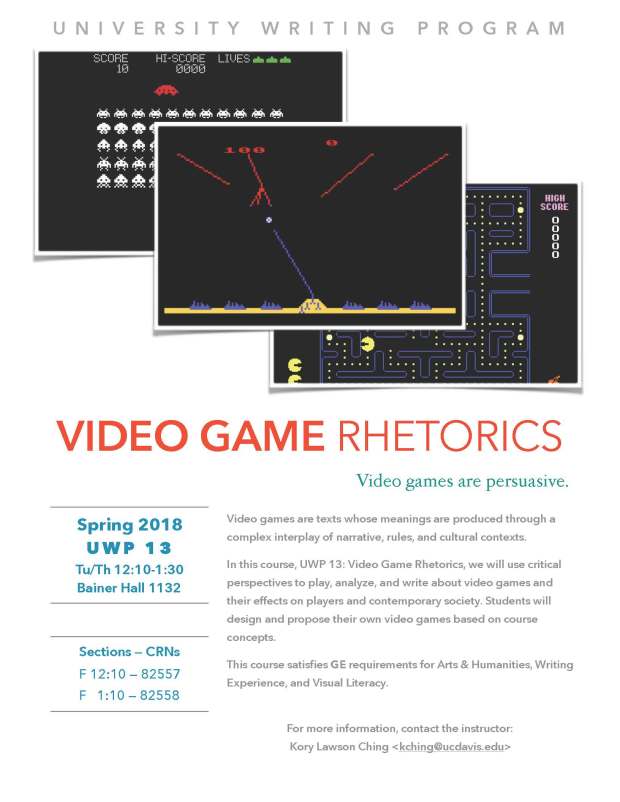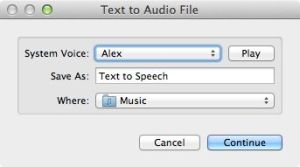
UWP 98: Video Game Rhetorics

Syllabus for “Teaching Writing in a Digital Age”
Syllabus for “Reading Videogames”
Tinkering and Learning
Annie Murphy Paul has a short piece on her blog about “The Joy of Making Things,” and it argues for a more hands-on, experimental approach to learning than one typically finds in school:
Research in the science of learning shows that hands-on building projects help young people conceptualize ideas and understand issues in greater depth. In an experiment described in the International Journal of Engineering Education in 2009, for example, one group of eighth-graders was taught about water resources in the traditional way: classroom lectures, handouts and worksheets. Meanwhile, a group of their classmates explored the same subject by designing and constructing a water purification device. The students in the second group learned the material better: they knew more about the importance of clean drinking water and how it is produced, and they engaged in deeper and more complex thinking in response to open-ended questions on water resources and water quality.
I haven’t read the study being referenced here, but it sounds like the intervention employed a kind of inquiry-based, learning-through-design approach. I would add that one possible advantage to this method, aside from the question of which way helps students “learn the material better,” is the affective dimension: How do students feel about the subject? What attitudes toward water resource management (or science more generally) were formed as a result?
Some of my own work (such as this) suggests that approaching a subject from an attitude of play and experimentation can profoundly affect later perceptions of (and practices within) that subject. Unfortunately, school isn’t typically set up to allow students much room to experiment, especially in this age of increasingly high-stakes standardized testing.
Jabari Mahiri Talk @ SFSU
SFSU Spring Composition Conference
Is the BSA’s Survey Collecting Data or Making an Argument?
 I just finished taking a survey sent out by the Boy Scouts of America (BSA) designed to ascertain attitudes among adult leaders toward the BSA’s discriminatory policy toward homosexuals. I also recently took a survey sent out from my local council on the same topic. In both, I indicated in no uncertain terms that the policy has got to go.
I just finished taking a survey sent out by the Boy Scouts of America (BSA) designed to ascertain attitudes among adult leaders toward the BSA’s discriminatory policy toward homosexuals. I also recently took a survey sent out from my local council on the same topic. In both, I indicated in no uncertain terms that the policy has got to go.
I worry, though, that surveys and polls like this imply that an upcoming national vote (likely to happen in May) to determine the fate of this backwards policy will depend in some way on how the issue polls among its members. The obvious problem with this, of course, is selection bias, in that many people who oppose the discriminatory policy have simply decided not to participate in scouting. So, any poll of current members and volunteers is likely to be in favor of keeping the policy.
But, as William Saletan’s recent piece over at Salon argues, there may be something else going on with that national survey. He says that it’s “biased toward dropping the ban”:
The structure of the questionnaire clearly challenges the organization’s members, leaders, sponsors, and alumni to rethink the ban on gays and to consider more nuanced alternatives. That bias isn’t the product of an agenda. It’s the product of moving beyond dogma and facing plausible scenarios in all their complexity. It’s the product of reality.
So, in other words, maybe this survey isn’t so much about gathering data on attitudes as it is a rhetorical attempt to prepare the wider membership for a change in current policy. What many don’t seem to understand is that a “more nuanced alternative” is a de facto reality, in that individual chartering organizations (like churches and civic clubs) already refuse to enforce the discriminatory national policy. Perhaps what we are seeing in the survey is an attempt to prepare scouters for the adoption of that reality as official policy. I hope so.
For the record, though, I should say that while a “let’s leave it up to individual councils or units” policy would be a welcome change, it still would not go far enough. The BSA really needs to adopt a policy of inclusiveness and non-discrimination that would be much more consistent with the values expressed in the Scout Oath and Law.
Convert Journal Articles to Audio Files on the Mac
A while ago, I wrote a post describing how to listen to PDF journal articles by converting them to Kindle format and using Kindle’s text-to-speech capability. This system helped me be productive on my long commute, but I recently discovered an even better solution. As it turns out, the Mac’s OS X comes with a pretty robust text-to-speech feature, and it’s remarkably easy to create audio files for playback on your computer or mobile devices.
Here’s how to do it:
- First, download (or scan) a PDF of a journal article. Make sure that the text is selectable. If it’s not, you may need to run optical character recognition (OCR) on it. I use Adobe Acrobat, which I find pretty reliable.
- Open the PDF in Preview, and select all the text (Command-A).
- Once the text is all selected, right-click (or Control-Click) on the text, find “Services,” and look for the item “Add to iTunes as Spoken Track.”
- When you click on that, you’ll see the following dialogue that allows you to choose one of the built-in voices and to name the file. I suggest sticking with the “Alex” voice.
- Click “Continue,” and your Mac will begin converting the text to a spoken audio file. When it’s done, open iTunes and find the track. You can listen to it as is, but I recommend changing its designation from “music” to “audiobook.” To do that, right-click (Control-Click) on the file and choose “Get Info.” Under “Options,” find where it says “Media Kind,” and select “Audiobook.”
Now you can add the file to playlists and sync it to your favorite media device. I put files on my iPhone, and then play them over the bluetooth connection in my car. Also keep in mind that you can adjust the speed of the text-to-speech voice in System Preferences, under “Dictation & Speech.” I found that just a little faster than “normal” works well, but your mileage may vary.
Enjoy!
Proposition 30 and California’s Future
Fellow Californians:
There’s a lot of money being spent to spread misinformation about Proposition 30. Please take the time to educate yourself about it before deciding how to vote. It boils down to a 0.25% increase in sales tax for four years and an income tax increase on people who make more than $250,000 a year (rich people, in other words).
What you won’t see in the voter information guide, though, is the human cost if we fail to pass this initiative. K-12 education will suffer the most, but a loss for Prop. 30 will also gut our already stressed higher ed. systems. Here’s how one writer over at the Huffington Post puts it:
If Prop 30 fails, both the University of California and California State University systems will get a $250 million cut. UC would likely increase tuition by a minimum of 20 percent to respond to the shortfall; CSU would likely raise tuition and admit 20,000 fewer students to respond to its own cut, according to reports. Community colleges would get another $338 million cut in the middle of the 2012-13 academic year, and faculty could expect more job losses and furloughs, not to mention a lack of a pay raise.
So, tuition will skyrocket, vital programs will be cut, and lots of teachers could lose their jobs. A college education will become an unattainable dream for many young Californians.
The thing is, we will all end up paying the costs for these people one way or another. Either we pass Prop. 30 and educate our kids to become productive members of our society, or we wait a few years and spend even *more* taxpayer money to care for (or incarcerate) those who fall through the ever-widening cracks.
I’ve said in the past that I’m not a big fan of California’s initiative system, but this one represents an important course correction. Our education system, from grade school through college, used to be the pride of the state, and California prospered because it understood the importance of investing in its own future. We’ve since lost our way, preferring to build prisons instead of human capital, but Prop. 30 would be an important move back in the right direction.











